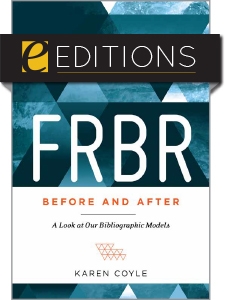
FRBR, Before and After: A Look at Our Bibliographic Models—eEditions e-book
The download link for this product can be found on the final confirmation screen after you complete your purchase, and may also be accessed from your Account Profile. For more information about ALA eEditions file types and how to view them on eReaders, desktop computers, and other devices, see this page.
Primary tabs
You don't need to be an ALA Member to purchase from the ALA Store, but you'll be asked to create an online account/profile during the checkout to proceed. This Web Account is for both Members and non-Members.
If you are Tax-Exempt, please verify that your account is currently set up as exempt before placing your order, as our new fulfillment center will need current documentation. Learn how to verify here.
- Description
- Table of Contents
- About the author
- Reviews
Coyle's expert ability to draw from the deep historical background of cataloging theory to illuminate the potentials of library data on the Web helped win her the 2011 ALCTS Outstanding Publication Award. Here she persuasively argues that to more effectively connect library users with books, movies, music, computer games, and other resources, library data needs to move beyond FRBR towards a more integrative approach to bibliographic models. But doing so requires fundamental changes in the approach to library data. Combing a sweeping perspective with a critical eye, she assesses how we define a work in the bibliographic world. Showing how bibliographic models reflect technology and our assumed goals of libraries, she points the way ahead for catalogers and metadata specialists, providing clear explanations and analysis on such topics as
- library data models and their connection to technology, from early printing to relational databases and the Semantic Web;
- ideas and influence of leading thinkers such Lubetsky, Wilson, and Tillet, along with lesser known theorists like Tanaguchi;
- IFLA meetings that led to the FRBR study group, including its original charge and final report;
- FRBR as a conceptual model, and how that differs from data models;
- the FRBR document's flawed entity-relationship model and how it overlooks user needs;
- efforts to define a work as a meaningful, creative unit separate from the physical package;
- detailed analysis of the FRBR entities; and
- implementations of FRBR both inside and outside the library community.
Coyle's articulate treatment of the issues at hand helps bridge the divide between traditional cataloging practice and the algorithmic metadata approach, making this book an important resource for both LIS students and practitioners.
List of Figures
Acknowledgments
Introduction
Part I Work, Model, Technology
1 The Work
2 The Model
3 The Technology
Part II FRBR and Other Solutions
4 FRBR in Context
5 FRBR: Standard for International Sharing
6 The Entity-Relation Model
7 What Is Modeled in FRBR
8 Does FRBR Meet FRBR's Objectives?
9 Some Issues that Arise
10 Bibliographic Description and the Semantic Web
11 Afterward
Bibliography
Index
Karen Coyle
Karen Coyle is a librarian and a consultant in the area of digital libraries. She worked for over 20 years at the University of California in the California Digital Library, has served on library and information standards committees, and had written frequently on technical topics ranging from metadata development, technology management, system design, and on policy areas such as copyright and privacy. Coyle is the recipient of the 2011 ALCTS Outstanding Publication Award for her "Understanding the Semantic Web: Bibliographic Data and Metadata," the January 2010 issue of Library Technology Reports.
”A seminal work that combines basic information with keen experience-driven insights."
— Reviewer's Bookwatch
”In this brief work Karen Coyle makes FRBR, short for Functional Requirements for Bibliographic Records, clear and understandable. This is no small feat, especially for those who approach the idea with some trepidation … a highly practical book for those preparing to transition. This book is recommended for academic libraries and catalogers looking to stay up-to-date in the field."
— Catholic Library World
"Coyle is an expert at explaining complex information technology in a way that is clear but never condescending, and detailed but never verbose."
— Against The Grain
” I assume it is safe to say that librarians nearly everywhere recognize [FRBR] and understand it at some level. Comprehending all it entails and what it holds for our future is altogether a different matter however. That is where this book proves valuable … Much of the language is rather technical, although this is helped by Coyle’s ability to create illustrations from real world situations in a way that is easily understandable and engaging. I found the layout and arrangement of chapters to be logical and there is an extensive bibliography and index, as well as a number of charts and diagrams to explain and clarify structures in FRBR and other models."
— Technicalities
“Coyle does an excellent job of clearly and concisely elucidating complex concepts that would be difficult to grasp in a lesser writer’s hands ... I highly recommend this clearly-written, insightful book to anyone who is interested in the theoretical underpinnings of modern cataloging and metadata management.”
— Technical Services Quarterly


